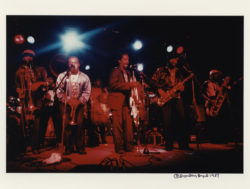Dirty Dozen Brass Band
The Dirty Dozen Brass Band began in 1977 as the Dirty Dozen Social and Pleasure Club by blending the music and culture of traditional New Orleans brass bands with social and pleasure club second lines.

Courtesy of Louisiana State Museum
Dirty Dozen Brass Band. Byrd, Syndey
Among the most widely recognized and recorded brass bands from New Orleans, the Dirty Dozen Brass Band has toured extensively throughout the world and recorded with such major acts as Norah Jones, Widespread Panic, Elvis Costello, and David Bowie, and in the process has expanded the traditional boundaries and fan base of the musical genre. The group played a central role in the New Orleans brass band renaissance of the 1970s, reviving and affirming the importance of the brass band tradition. At the same time, it introduced contemporary elements of jazz, bebop, funk, jam bands, and popular culture into its performances, attracting new generations of listeners and performers with its dynamic sound.
From the Neighborhood to the Global Stage
The Dirty Dozen Brass Band originated from an outreach youth music program begun by Danny Barker at New Orleans’s Fairview Baptist Church in 1970. After the church’s marching band disbanded in 1974, members went on to form other groups, including the Tornado Brass Band. Though this band eventually fragmented as well, core members—including brothers Kirk and Charles Joseph, and trumpeter Gregory Davis—continued to rehearse together. In 1977 they formed the Sixth Ward Dirty Dozen Band, after drummer Benny Jones asked them to perform in a parade hosted by the Dirty Dozen Social Aid & Pleasure Club, from which the band derived its name.
With strong ties to New Orleans’s Sixth Ward and Treme neighborhoods, the Dirty Dozen began playing regularly at such clubs as Daryl’s in the Seventh Ward and at the Glass House in the Central City neighborhood, a favorite hangout of John “Dizzy” Gillespie and other touring musicians. It was at regular Monday-night gigs at the Glass House that the band’s sound and performance style began to coalesce. Southern University also influenced the Dirty Dozen’s development. According to band member Roger Lewis, he and Charles Joseph studied there under Edward “Kidd” Jordan, the famous New Orleans jazz saxophonist.
In 1980, a time when brass band music had waned in popularity, disc jockey Jerry Brock made the first professional recording of the Dirty Dozen and promoted it heavily on New Orleans community radio station WWOZ. The band then formed its own record label, Mad Musicians, and, as Lewis recalled, released two 45-rpm records featuring the brass band standards “Lil Liza Jane,” “My Feet Can’t Fail Me Now,” and “Blackbird Special.” The heavy promotion and rotation of these recordings led to a seminal 1982 concert at the famous New Orleans music venue Tipitina’s. The high visibility of this performance, a strong local following, and the buzz created by their recordings and promotion eventually led to a 1984 European tour organized by producer George Wein, co-founder of the New Orleans Jazz & Heritage Festival. Ongoing stints at famed New York City jazz clubs soon followed. The recording of My Feet Can’t Fail Me Now, their first full-length album, by Concord Jazz in 1984 placed the Dirty Dozen on the global stage.
Stardom and Influence
In 1987, after signing with Columbia Records, the Dirty Dozen released Voodoo, which featured guest appearances by Branford Marsalis, Dr. John, and Dizzy Gillespie. The album began a series of collaborations with high-profile musicians. Voodoo also led to the development of a jam-band, arena-rock performance style, solidified through tours with Widespread Panic and The Black Crowes as well as work with John Medeski of the band Medeski Martin & Wood. During years of recording for Concord, Rounder, Sony, Mammoth, and Ropeadope Records, among other labels, the band gradually reincorporated more of the traditional New Orleans brass band form and function into its work, as exemplified by Funeral for a Friend (2004), a nod to the jazz funeral music of New Orleans brass bands. After Hurricane Katrina ravaged their hometown in 2005, band members contributed the song “Mardi Gras in New Orleans” to the benefit album A Celebration of New Orleans Music. This was followed by their 2006 release, What’s Going On, a reinterpretation of Marvin Gaye’s 1971 album. This 2006 release served as both a musical ode to Gaye and a searing post-Katrina sociopolitical critique. In 2009 the Dirty Dozen joined Allen Toussaint and Lil Wayne on stage at the Grammy Awards ceremony in a tribute to New Orleans music.
The Dirty Dozen Brass Band is globally recognized for its blowout stage performances, its combination of diverse styles, and its collaborations with a wide range of musicians. At the same time, the group angered some jazz purists by incorporating contemporary elements into the traditional New Orleans brass band style. While some see this experimentation as a direct threat to the tradition’s survival, others insist that traditions must be free from constraint to survive. For the latter audience, the Dirty Dozen’s ability to attract scores of younger musicians to brass band music outweighs any loss of traditional sounds. Indeed, many members of the original band and their musical protégés have formed their own brass bands. Some, like the Treme Brass Band, adhere to the classic traditional brass band style more strictly, while others push the genre’s boundaries even further.
Band Members
Over the Dirty Dozen’s three-decade career, many band members have come and gone. Among its core members are Kirk Joseph (sousaphone), Charles Joseph (trombone), Benny Jones (drums), Efrem Towns (trumpet), Roger Lewis (baritone sax), Kevin Harris (tenor sax), Gregory Davis (trumpet), Terence Higgins (drums), Jake Eckert (guitar), Jenell Marshall (drums), Richard Knox (piano), Julius McKee (sousaphone), Cedric Sanders (piano), “Big” Sam Williams (trombone), Carl LeBlanc (guitar), Keith Anderson (sousaphone), and John Hermann (sound). Drummer Lionel Batiste died in July 2012.
